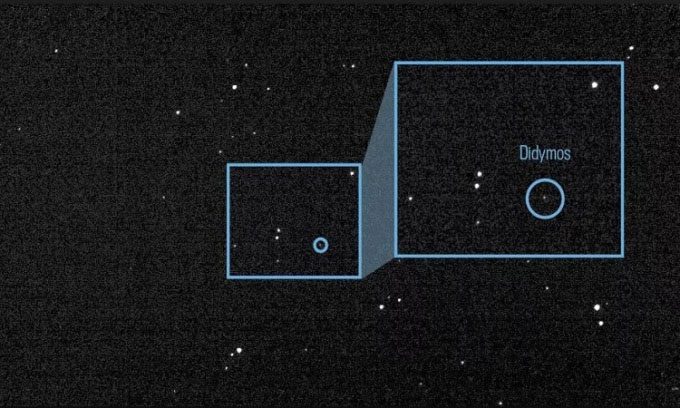The NASA Double Asteroid Redirection Test (DART) spacecraft has transmitted its first images of its target, the moonlet Dimorphos, and the asteroid it orbits, Didymos.
DART is a planetary defense test mission designed to impact the moonlet Dimorphos, thereby altering its orbit around the asteroid Didymos. If this design proves effective, researchers could scale up the spacecraft to protect Earth from asteroids that pose a collision risk. Didymos and Dimorphos are not threats to Earth but serve as targets for testing kinetic impact technology.

Asteroid Didymos and moonlet Dimorphos as captured by DART’s DRACO instrument. (Image: NASA)
The image of Didymos is a composite made from 243 individual photos taken by the Didymos Reconnaissance and Asteroid Camera for Optical Navigation (DRACO). DRACO captured the series of images on July 27, but NASA only shared the complete image on September 7. In the image, both Dimorphos and Didymos appear as bright dots. At that time, the spacecraft was still 32 million kilometers away from the asteroid. DART is scheduled to collide with Dimorphos at 6:14 AM on September 27, Hanoi time.
“This first series of images is being used to test our imaging techniques,” shared Elena Adams, DART mission systems engineer at the Johns Hopkins University Applied Physics Laboratory in Maryland. “The image quality is similar to what we could obtain from ground-based telescopes. But what’s important is that DRACO is functioning well and can see the target to make adjustments if needed before we guide the spacecraft to autonomously collide with it.”
DART will use DRACO to navigate to the collision area completely independently of ground control operators on Earth. Over the next three weeks, the team will use the images taken every five hours to adjust the trajectory, ensuring DART accurately flies toward the Didymos system. Then, within 24 hours before impact, DART will execute its final approach. “After seeing the first images from DRACO, we can best position DRACO and adjust the software,” said Julie Bellerose, DART mission navigation lead at NASA’s Jet Propulsion Laboratory in California.


















































